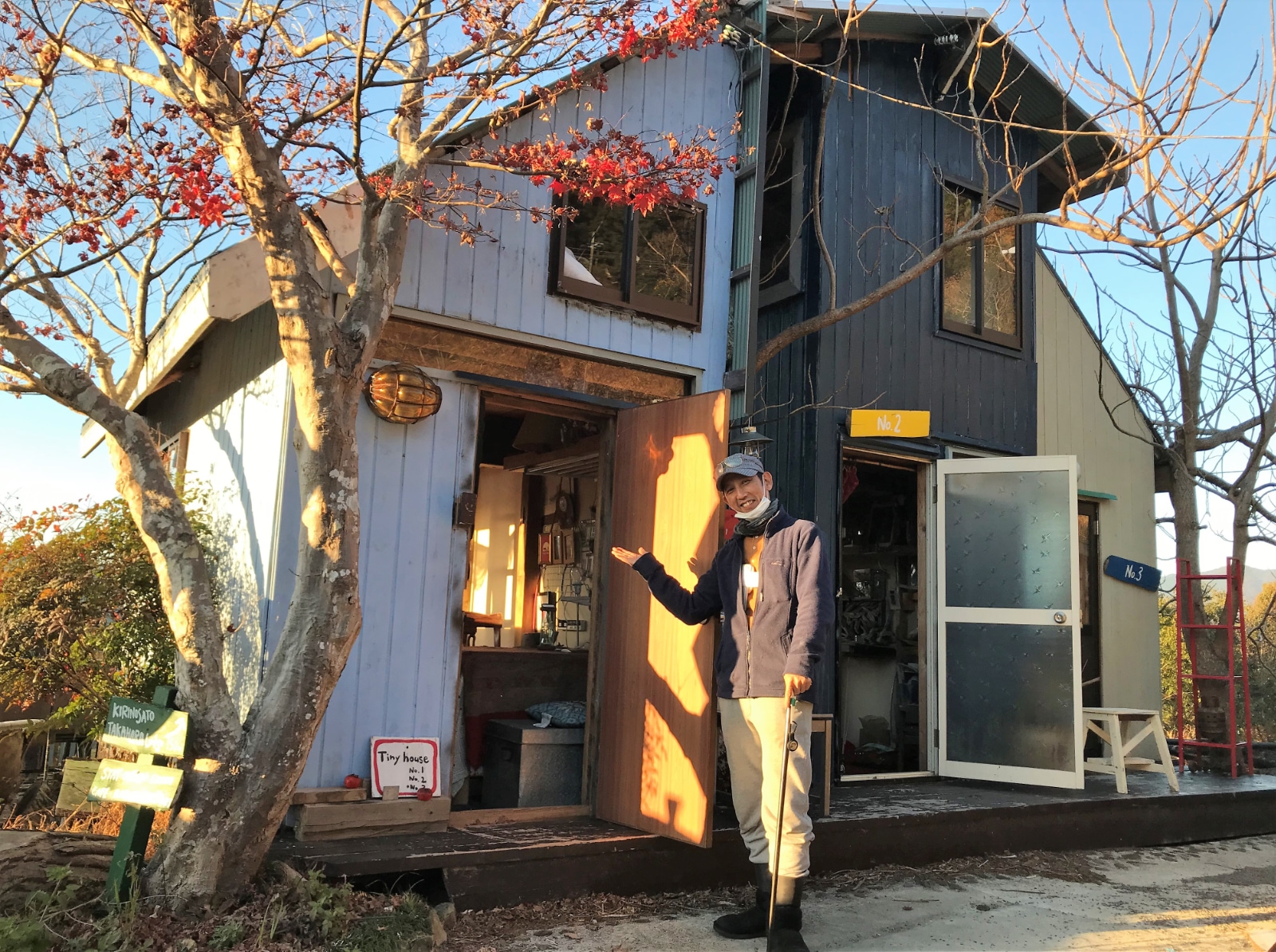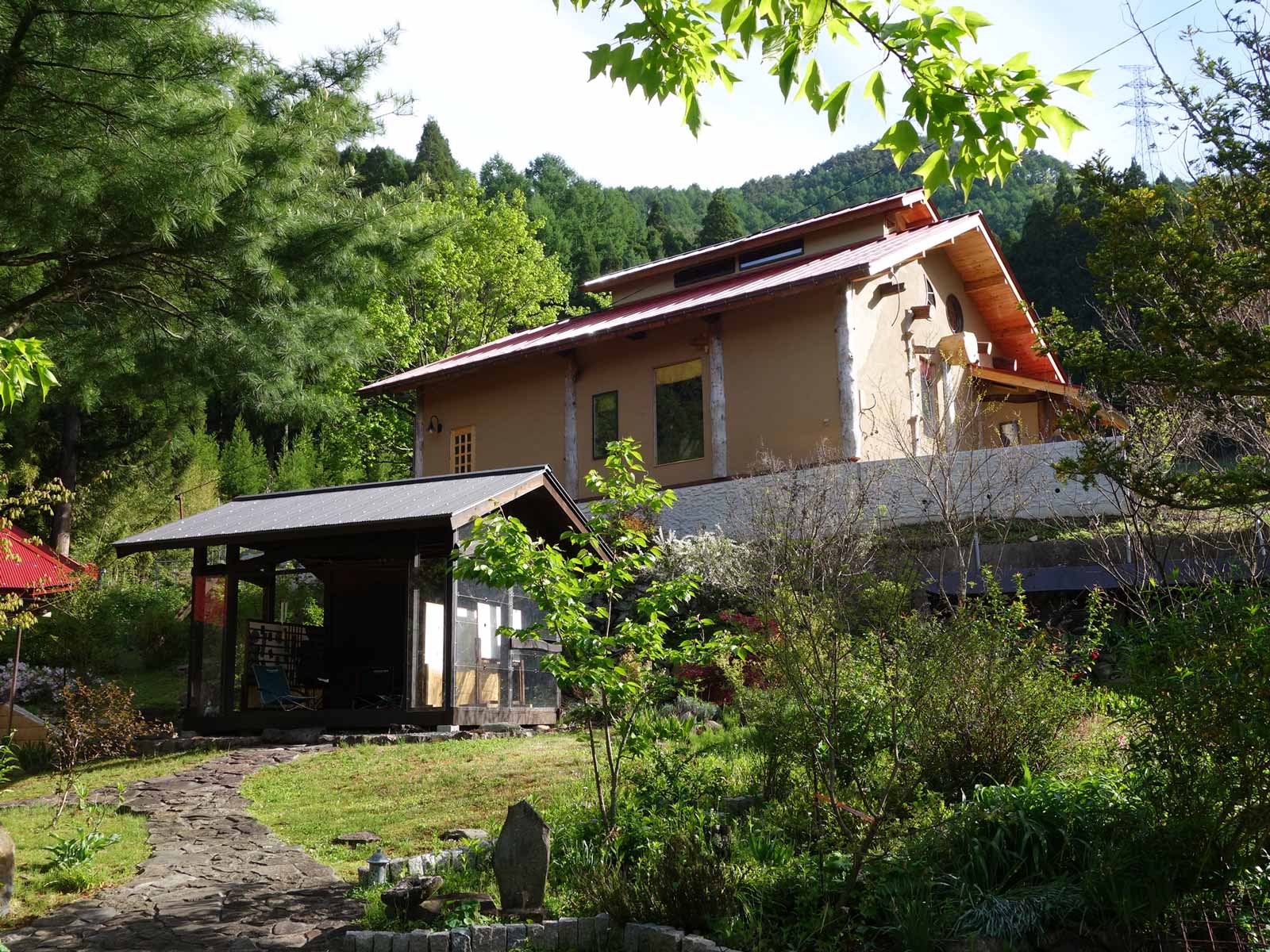The abundance of akiya (vacant houses) dotted all over the Japanese countryside has hit the headlines in recent years. While some of these empty houses make it into the municipalities’ Akiya Banks, many are already uninhabitable.
Despite Japan’s zero waste policy, the idea of salvaging lumber and other materials from these old houses has not caught on yet but there are some promising examples where individuals took it upon themselves to rescue such materials and re-use them for building interesting new structures.
Tiny houses in Kumano

One such example is found in Wakayama Prefecture at the Organic Hotel Kiri-no-Sato in Kumano. Owner and manager Jian Shino decided to add some lodging facilities for his volunteer workers and he researched the internet for ideas.
“I came across tiny houses on wheels that are popular in the U.S. The concept of small and self-build got stuck in my head. So I started talking about ‘my dream’ with locals and guests,” he remembers.
One of the locals who owns a company that demolishes old houses agreed to call Shino the next time an old house was due for break-down. Together they marked the beams and posts to be saved and transported to Kiri-no-Sato.
After the building material was secured, soon other help emerged amongst guests. An Australian was a hobby builder and an Italian turned out to be an architect. They gave practical advice and created the design for the tiny houses to be built in return for “king treatment” at Kiri-no-Sato.
During the coronavirus pandemic the Kiri-no-Sato team got a break from servicing the otherwise endless stream of international guests and they used this free time to build the tiny houses. From the idea in 2017 to the finished three houses, they worked three and a half years on the project “bit by bit”.
Shino already knew that any newly built structure of less than nine square meters on privately-owned land does not need a building permit. So he and his staff set out to build the first tiny house by themselves. They got help from eight volunteer workers to build two more houses. The volunteers slept in these houses and thereby they “experienced” them.
“They felt the house shake in the wind, listened to the loud noise of rain on the metal roof, considered ventilation in the air-con-less houses and the movement of bugs in and out of the rooms,” explains Shino, who thinks that such nature-based sense experiences will be important after the coronavirus pandemic.
Zen dojo in Nagano

Dorothee Eshin Takatsu who runs Horakuan Temple and Zen Buddhist Retreat Center near Suzaka in Nagano Prefecture wanted to rescue the wood from a huge old cedar tree that had to be felled in the neighborhood. She contacted a construction company to get help with the transport.
When being asked what she wanted to do with it, she explained her vague idea of building a dojo for practicing Zen. The company owner then took her to his lumberyard and showed her old beams neatly stacked and aired under a big roof.
“I could hardly believe my eyes and much less my ears when he said I could use them. How fortunate that this construction company did not just destroy them as waste,” she says.
Now she had 60 old beams and a 10-meter-long cedar tree trunk. The challenge was to find a carpenter who had the skills and knowledge to use them.
The owner of the construction company introduced Dorothee to his friend who was an independent carpenter. He refused initially due to his advanced age but after a lot of persuasion agreed to take on this project and sent photos of his previous work.
“The use of old beams, new pillars, white plaster walls and the various combinations of different kinds of wood and integrated branches — I had never seen anything like that in Japan before,” she remembered.

He and four young carpenters began to assemble the ceiling construction. This work took several months due to the different measurements and the necessary fine-tuning of each crooked beam. By now the concrete foundation was done and the actual construction of the building could begin. It took two years to construct the building. Due to the remoteness of the location no building permit was needed.
For the inside too, natural materials were used as much as possible: plaster (shikkui) for the walls, hemp cloth for the ceiling and branches cut in the wood for handrails. For the stairs and for the altar, old planks were recycled from a temple near Kyoto and all the doors were rescued from traditional Japanese houses that were about to be burnt.
“Especially beautiful are the inside four doors, more than 200 years old, that had gathered dust in the attic of a temple in Wakayama. For the entrance I got an old massive storehouse door from a recycle shop,” Dorothee says.
This combination of new and old gives the building a distinct, one-of-a-kind atmosphere.
“People who come to visit and use the space are all amazed by the result. They feel comfortable right away because the old beams and doors give this building a quiet, settled down atmosphere that feels comforting,” she says.
Lessons for the future

Shino doesn’t think much of modern “box houses”: “They are cheap and convenient but ugly and without feeling. Their design is computer-calculated, the material is always a standard 2 x 4 inches, the builders are rushed and the interior is assembled by Ikea Planner,” laments Shino.
On the contrary, salvaged wood and materials from old houses are a real treasure for him. He thinks that “some sort of system” is needed to recycle and reuse more wood from the many dilapidated houses in rural Japan.
“We need a sustainable building system and we need to teach young carpenters to talk with nature again and train them how to use this old wood!”
Dorothee thinks along the same lines: “Recycling old material is not only about saving beautiful material but also about preserving history. By re-using them, the old building techniques are preserved too. Since few people build traditional houses nowadays these techniques are getting lost very fast.”
“Losing old houses and the techniques to build them would end up as a huge cultural loss for Japan.”
© Japan Today















3 Comments
Login to comment
kohakuebisu
Old beams, old doors, etc. can add tons of character when incorporated in new buildings. When saving timbers from an old house, expect to pay to have the house dismantled rather than demolished, a far more violent process that uses chainsaws and heavy machinery. The Zen space pictured has a nice exterior, but the main room looks busy and cluttered inside. A standard washitsu, with fewer curves, angles, and colours, is more harmonious.
Tiny homes are interesting and have potential beyond short-term/holiday accommodation.
ListenTheTruth
Excellent. Stop the waste and build homes anew with old!
Nils W
The problem in Japan, as with many other countries, is that the beautiful old houses are over there, but the people are over here! In Sweden, the lovely old houses are in northern Lappland but the people live around Stockholm, 1,500 km south!
So we just move the houses, and that’s what we do in Japan as well, at www.HeritageHomesJapan.com
we dismantle the ‘kominkas’, restore the beayold hardwood beams, columns, flooring etc, ship it to wher the customer is, and re-build it, using proper insulation, modern kitchens & bathrooms, triple glazed windows etc.
if you love Japanese old Japanese farmhouses but don’t want to live miles from nowhere, this is the way to go.